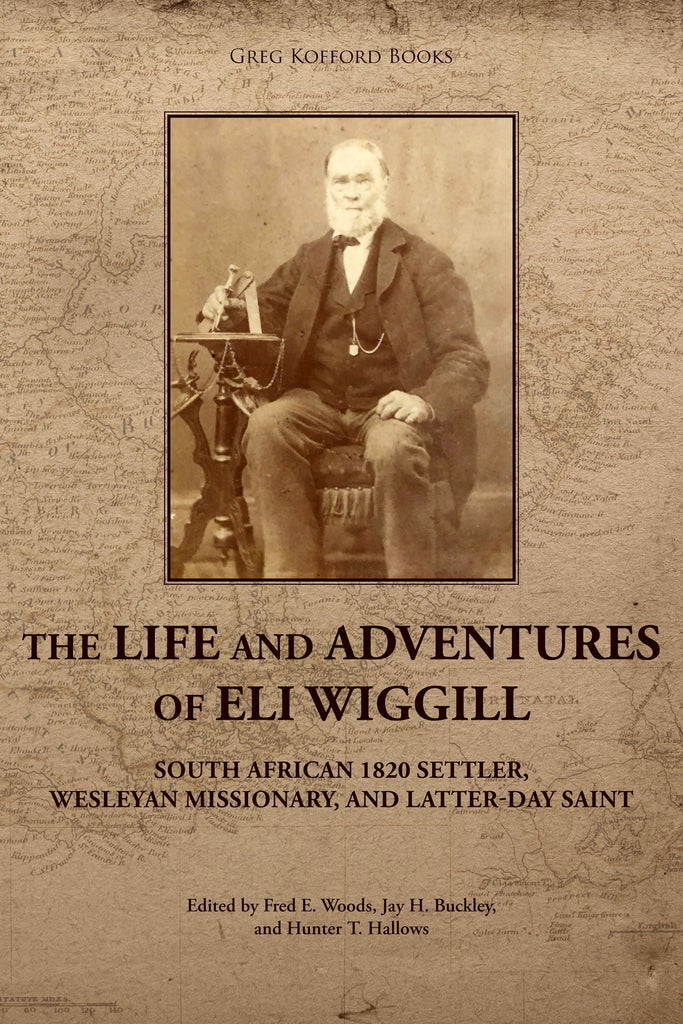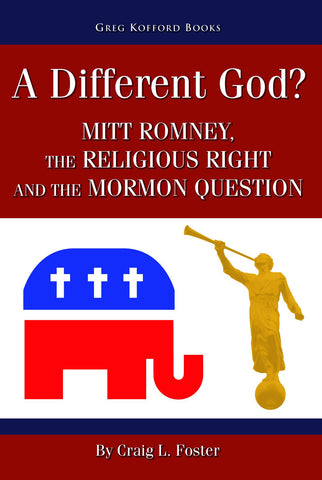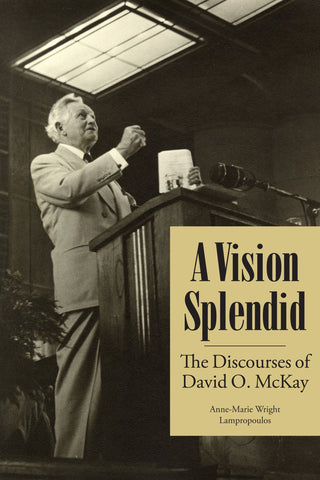The Life and Adventures of Eli Wiggill: South African 1820 Settler, Wesleyan Missionary, and Latter-day Saint
$31.95
edited by Fred E. Woods, Jay H. Buckley, and Hunter T. Hallows
Now available in paperback and ebook!
- “Provides a fascinating view into British, African, and American history and demonstrates how the Latter-day Saint experience brings them all together.” — Jeffrey G. Cannon
- “Offers readers insight into a variety of subjects, including British colonialism in South Africa, religious rivalry in the Atlantic world, slavery and emancipation in the British empire, and family life in the nineteenth century.” — Christopher Cannon Jones
- “Reveals a story of faith, courage, and devotion. . . . Eli Wiggill’s autobiography is worthy of a careful read to appreciate and comprehend his astonishing transnational adventures in Africa and Utah.” — Michael T. Lowe
- “An invaluable primary source of information on early Latter-day Saint history on the African continent that deserves careful study.” — Ryan Lee



Available in ebook for Kindle, Apple, Google Play, and, Kobo.
Also available through Amazon.
Download a free sample preview.
Book Description:
The autobiography of Eli Wiggill offers a captivating narrative of one family’s journey from Gloucester, England, to South Africa, and eventually to Salt Lake City during the mid-nineteenth century. Eli and Susannah Wiggill’s conversion to The Church of Jesus Christ of Latter-day Saints in South Africa serves as a focal point in their remarkable story. Eli’s retelling vividly portrays their steadfast faith, missionary efforts, and the challenges they faced as pioneers in establishing communities of South African Saints. From their immigration to South Africa to their eventual migration to Zion, the Wiggills' experiences offer valuable insights into the early history of the Church and the global gathering of its members.
With meticulous attention to detail, The Life and Adventures of Eli Wiggill: South African 1820 Settler, Wesleyan Missionary, and Latter-day Saint presents Wiggill’s original manuscript, enriched with extensive footnotes providing context and clarity. This publication aims to rectify previous shortcomings by preserving the integrity of Wiggill’s narrative while enhancing accessibility for contemporary readers. It not only chronicles a remarkable transnational journey but also sheds light on themes of faith, perseverance, and the pioneering spirit, making it a compelling read for historians, scholars, and anyone interested in the early history of The Church of Jesus Christ of Latter-day Saints and the global migration of its members.
Q&A with the Author:
.
Q: What were the driving factors behind Eli Wiggill and his family’s decision to leave England and settle in South Africa, and again to later migrate to Salt Lake City, Utah Territory?
A: Parliament recruited British emigrants to establish a South African colonyto ease unemployment and social unrest while strengthening Britain’s foothold in South Africa’s Cape Province. Isaac and Elizabeth Grimes Wiggill and their eight children, from Painswick, Gloucestershire, England, were one of the fortunate five percent of families chosen to participate. On January 10, 1820, the Wiggills embarked from Bristol, joining the Samuel Bradshaw Company of 64 emigrants aboard the Kennersley Castle, arriving in Cape Town, South Africa, on March 5, 1820, after a four -month voyage from England. Eli and Susannah Wiggill joined The Church of Jesus Christ of Latter-day Saints in 1858. They moved to Port Elizabeth, where Wiggill served as LDS conference president. His friend Henry Talbot served as president of the branch, which consisted of thirty to forty members. Church officials directed Saints around the world to gather to Zion as soon as possible. In February 1861 the congregation boarded the Race Horse and sailed to Boston, arriving on April 19,1861. They traveled to New York, joined with other LDS emigrants, journeyed by rail to Chicago, and thence to the wagon outfitting station at Florence, Nebraska. The Homer Duncan Company departed June 25, arriving in Salt Lake City on September 13, 1861.
Q: How did Eli Wiggill's experiences as a Wesleyan Methodist assistant minister contribute to his eventual conversion to The Church of Jesus Christ of Latter-day Saints?
A: Eli Wiggill accompanied Reverend John Edwards as a minister to the “Bechuana” country beyond the Orange River. Although Wiggill had not formal ministerial training, he had a good understanding of the Bible. Wiggill labored in the Wesleyan Methodist Church ministry at the Thaba Nchu Wesleyan mission station. After his release on May 1, 1842, he traveled with his wife and two children to Winterberg and built a farm and went into business making wagons before moving to Queenstown. Wiggill remained active in his Wesleyan faith and occasionally preached at the Kat River mission station as well as at Fort Beaufort. Wiggill heard that Latter-day Saint missionaries had arrived at Fort Beaufort. The missionary trio of Jesse Haven, William Walker, and Leonard Smith initially arrived in South Africa on April 19, 1853, and preached and published tracts in Cape Town in both English and Dutch. They met with great opposition throughout their labors and were mobbed, having bricks and stones and rotten eggs thrown at them. Elder William Walker converted Eli’s brother George. Eli wrote, “When I heard Walker explain things in the manner he did I could not help [but] believe the truth of it.” In February 1858, Wiggill traveled to Winterberg to see George. Together they traveled to the Kat River settlement, where LDS Elder John Green, a former Wesleyan, baptized Eli, Susannah, and daughters Sarah Ann and Margaret on March 1, 1858. That same day, Wiggill was ordained a priest, which authorized him to perform baptisms as a member of the Church of Jesus Christ of Latter-day Saints.
Q: What challenges did Eli and Susannah Wiggill face as early converts to Mormonism in South Africa, and how did they overcome them?
A: Wiggill’s study of the Gospel of Jesus Christ filled his mind with light and knowledge. This awoke the missionary spirit in him so much so that he “had a great many arguments with religious people with whom I was surrounded and especially with my Wesleyan Brethren.” Unfortunately, his zeal towards a peculiar and foreign religion brought harsh criticism, censure, and opprobrium from their acquaintances. Susannah asked him to stop investigating further. Eli complied with Susannah’s wishes for a time and stopped investigating the Church. Local preachers told their congregations to shun and spurn the missionaries. Angry mobs harassed LDS missionaries and dispersed LDS gatherings. The backlash against the Latter-day Saints kept the Church from gaining converts very quickly and sparked fear of reprisal for the few who did join. Missionaries did not find willing converts for months due to the intense persecution. Although not yet a member, Wiggill overcame his social fear of conversion and became somewhat of a missionary. He related how his own preaching changed because of the additional light and knowledge he found in the Latter-day Saint religious tradition, as well as a greater outpouring of the holy spirit. After about a year of unofficial dedication to the church, Elder John Green baptized the Wiggills on March 1, 1858.
Q: Can you elaborate on the process of gathering the South African Saints to Zion in the mid-nineteenth century, as documented in Eli Wiggill's autobiography?
A: Eli Wiggill's autobiography describes how early missionaries spread the message of The Church of Jesus Christ of Latter-day Saints and how early converts lived their new faith in fledgling branches and left their homes and homelands to gather to Zion. During the nineteenth century, Church leaders instructed LDS members to gather to a central place in the United States.First it was Ohio, then Missouri, then Illinois. After the Latter-day Saints were driven from Nauvoo, Illinois, they trekked west to the valley of the Great Salt Lake in 1847. For the next fifty years, converts from all over the world were instructed to gather to Zion. Between 1855 and 1865, at least 270 Saints emigrated to the United States from the Port Elizabeth seaport, the most populous city in the Eastern Cape Province. Most of these early converts were of British descent and many came from the 1820 British Settler groups since the early missionaries did not speak Afrikaans, Dutch, Xhosa, or Zulu. The first South African Saints sailed from Port Elizabeth in 1855. In the 1890s, Church leaders no longer asked Saints to cross oceans or continents to gather to Zion but to build up The Church of Jesus Christ in their local stakes of Zion.
Q: What role did Eli Wiggill play in the establishment and leadership of Latter-day Saint congregations both in South Africa and in Utah Territory?
A: Eli and Susannah Bentley Wiggill joined The Church of Jesus Christ of Latter-day Saints in 1858 and became stalwart members following their conversion. Their faithful dedication affected the lives of dozens of South African Saints. Following their conversion to the restored gospel, their missionary labors, their leadership role in congregation formation, and their efforts to gather to Zion whilst building up and strengthening communities of South African Saints reverberated during the 1850s, 1860s, and 1870s. Their great faith and missionary efforts after their conversion provide insights into early church organization and the formation of branches. Finally, Wiggill’s autobiography documents how Eli and Susannah’s experiences represent one of the most well-documented accounts of South African Saints answering the call to immigrate to Zion.
Q: How did Eli Wiggill's missionary efforts in South Africa contribute to the growth and development of The Church of Jesus Christ of Latter-day Saints in that region?
A: One of the downsides of having converts continually gathering to Zion was that the Church struggled for continuity in countries around the world during the nineteenth century. The same is true for South Africa. Opened as mission in 1852, the South African Mission closed on April 12, 1865. The South African Mission was reopened until July 25, 1903. The historical setting surrounding Eli and Susannah Bentley Wiggill and their nine children reveals a story of faith, courage, and devotion as one of the first South African families to join The Church of Jesus Christ of Latter-day Saints. Wiggill’s autobiography is worthy of a careful read to appreciate and comprehend his astonishing transnational adventures in Africa and Utah. The Life and Adventures of Eli Wiggill is more than a little-known Latter-day Saint conversion narrative, more than a missionary memoir, and more than an account of emigration and pioneer settlement (though it is all the above). It offers readers insight into a variety of subjects, including British colonialism in South Africa, religious rivalry in the Atlantic world, slavery and emancipation in the British empire, and family life in the nineteenth century.
Praise for The Life and Adventures of Eli Wiggill:
“Eli Wiggill’s autobiography provides a fascinating view into British, African, and American history and demonstrates how the Latter-day Saint experience brings them all together. Through extensive footnotes on topics from botany to history, the editors provide the reader with the necessary information to understand Wiggill's everyday world. Scholars and interested readers can see a glimpse in Wiggill's writing of how early missionaries spread the message of The Church of Jesus Christ of Latter-day Saints and how early converts lived their new faith in fledgling branches and left their homes to gather to Zion.” — Jeffrey G. Cannon, Laura F. Willes Research Associate at the Neal A. Maxwell Institute for Religious Scholarship
“The Life and Adventures of Eli Wiggill is more than a little-known Latter-day Saint conversion narrative, more than a missionary memoir, and more than an account of emigration and pioneer settlement (though it is all of the above). It offers readers insight into a variety of subjects, including British colonialism in South Africa, religious rivalry in the Atlantic world, slavery and emancipation in the British empire, and family life in the nineteenth century. The editors deserve credit and gratitude for their careful work in making this important source more widely available to readers and researchers.” — Christopher Cannon Jones, co-editor of Missionary Interests: Protestant and Mormon Missions in the Nineteenth and Twentieth Centuries
“The historical setting surrounding Eli and Susannah Bentley Wiggill and their nine children reveals a story of faith, courage, and devotion as one of the first South African families to join The Church of Jesus Christ of Latter-day Saints in the 1850s. Eli Wiggill’s autobiography is worthy of a careful read to appreciate and comprehend his astonishing transnational adventures in Africa and Utah.” — Michael T. Lowe, author of African Eden and African Eden II, published family histories of the Lowe and Wiggill ancestral lines in South Africa.
“Eli Wiggill offers us an eye-witness account as a member of the 1820 inaugural group of settlers from England to its newly acquired Cape Colony in South Africa. He candidly describes his life, his family, and career as a farmer, master wagon maker around the colony, and the natural environment. Then in the late 1850s he encounters missionaries of The Church of Jesus Christ of Latter-day Saints and becomes a leader of the group in the Colony before emigrating to Utah in the United States. In the 1870s he returns to South Africa for a few years to visit friends and family where he notes the many changes in the Colony. He’s an ordinary man who leads a remarkable life and we are privileged to have his journal as he wrote it. Particularly since both he and his friend Henry Talbot are my family’s ancestors.” — Riley Moffat, retired senior librarian at Brigham Young University Hawaii and co-author of Saints of Tonga, Gathering to La‘ie, and the Palapala ‘Aina series of volumes on the history of the mapping of Hawai‘i.
“This is an invaluable primary source of information on early Latter-day Saint history on the African continent that deserves careful study, especially given the meteoric rise of the Church in this area of the world. It is rare to have any documents from this era and region of the history of the Church of Jesus Christ of Latter-day Saints, let alone one that provides such rich details of nineteenth-century Latter-day Saint, as well as Wesleyan, missionary efforts in southern Africa. The Eli Wiggill autobiography is a valuable historical source with rich potential for further exploration by scholars of Latter-day Saint history and missiology in Africa. The L. Tom Perry Special Collections at Brigham Young University is honored to hold the original manuscript of the autobiography.” — Ryan Lee, Accessioning Archivist, Brigham Young University
“His life’s journey, which spans across three continents and includes conversion to the Church of Jesus Christ of Latter-Day Saints while serving as a Wesleyan missionary, is noteworthy. . . . Readers get a sense of the mindsets, terminology, and culture of people in the 19th century. . . . The Life and Adventures of Eli Wiggill can be appreciated for helping to provide more readily accessible source material for future studies of early members from lesser-known areas of the world.” — Richard Ji, Association for Mormon Letters
About the Editors:
Fred E. Woods (PhD, University of Utah) has worked at Brigham Young University as a professor of Religious Education since 1998. From 2005–2010 he held a Richard L. Evans Professorship of Religious Understanding and a BYU Moral Education Professorship from 2019-2021.
Jay H. Buckley (PhD, Nebraska) is an Associate Professor of History at Brigham Young University, where he teaches American West, American Indian, and America history courses. Since 2001 he has directed the American Indian Studies Minor and is the current Director of the Charles Redd Center for Western Studies.
Hunter T. Hallows (BS, Brigham Young University) is currently working towards a Juris Doctor degree from the Alexander Blewett III School of Law at the University of Montana.
More Information:
293 pages
ISBN 978-1-58958-804-2
Press sheet






Share this item: